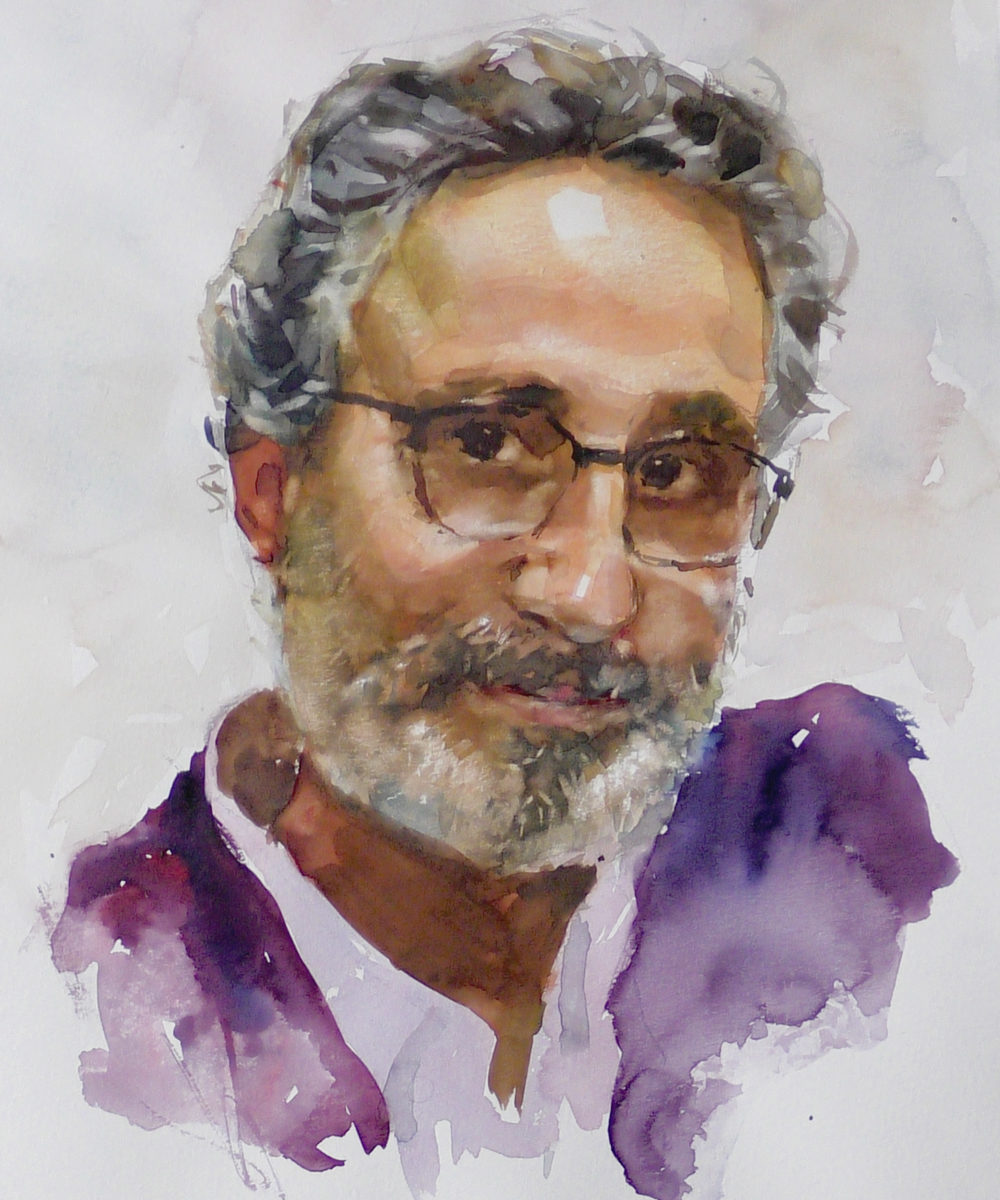Today, May 18, I launch my newest video tutorial. How to paint a portrait in watercolour. Continue reading “How to paint a portrait in watercolour”
I loved all kinds of drawing
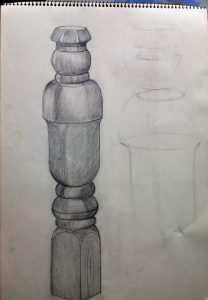 When I was 11 years old I received my first drawing lessons from Beatus Nijs. I´ve written about him before. To him I owe much of the success of my entire career. He was like a father to me. He encouraged me enormously and made me draw everything that was available. He once gave me a table leg to study as homework. I found a drawing pad of mine from 1964 with this pencil drawing. I was 13 years old. If you look closely you can see on the right side Beatus´ drawing correction. Continue reading “I loved all kinds of drawing”
When I was 11 years old I received my first drawing lessons from Beatus Nijs. I´ve written about him before. To him I owe much of the success of my entire career. He was like a father to me. He encouraged me enormously and made me draw everything that was available. He once gave me a table leg to study as homework. I found a drawing pad of mine from 1964 with this pencil drawing. I was 13 years old. If you look closely you can see on the right side Beatus´ drawing correction. Continue reading “I loved all kinds of drawing”
Where are the gouache strokes?
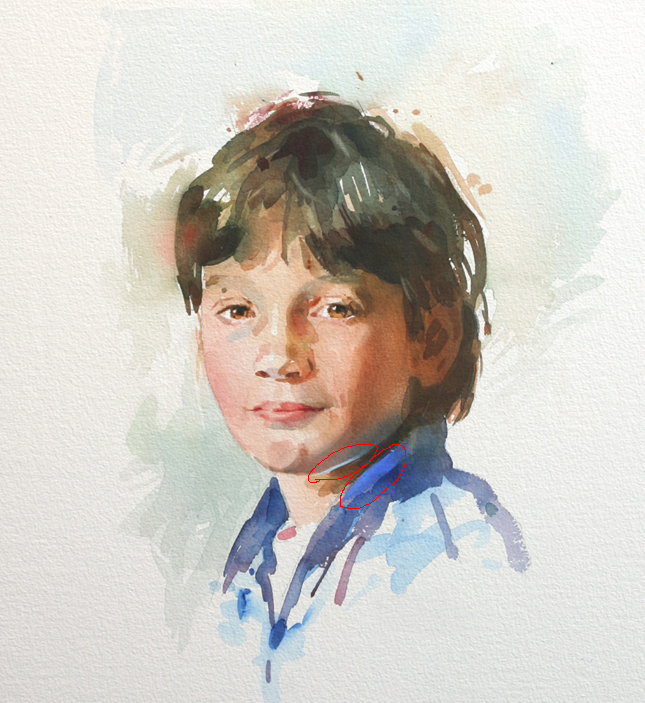
The answer to my question of two weeks ago, where in this watercolour portrait I applied two gouache strokes, is this: the bright reflected light under the chin and the blue accent on the collar of the shirt. Among the good answers I raffeld a DVD.
The DVD goes to:
Marija Gaspar from Zagreb. Congratulations Marija!
Thank you all for your participation.
Eternal gaze
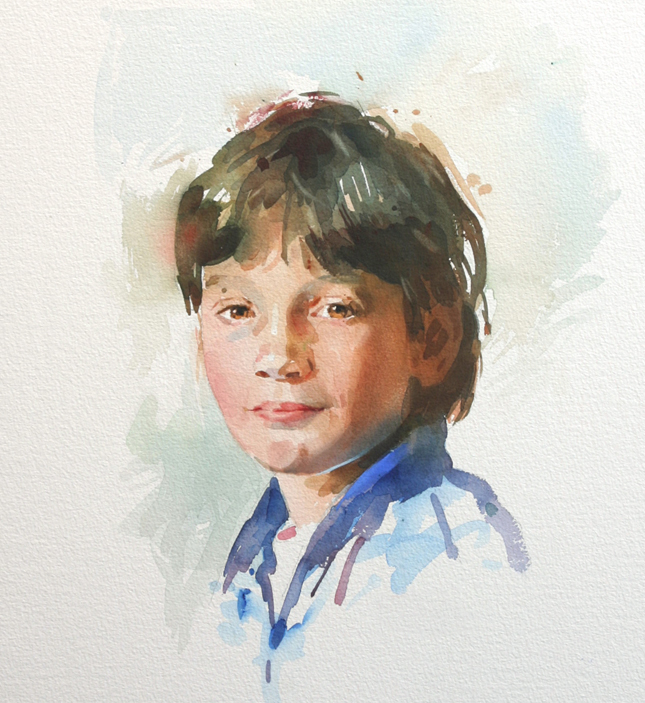
This is a commissioned portrait in watercolour that I made years ago. During the sitting I noticed the independent and tranquil look of this little boy.
“An artist is not a psychologist,” I quoted in one of my last posts. Yet a portrait painter is happy if he sees a quality in a face he wants to emphasize. So was I and I tried to capture this pensive look. I was sincerely happy when the mother exclaimed: “Yes, this is my son with his eternal gaze!“.
The portrait is in watercolour but there are two brushstrokes in gouache. I wonder if someone can find them? Among those who give the right answer I will raffle a video demonstration. Let’s say up to a fortnight.
Portrait painting and imagination
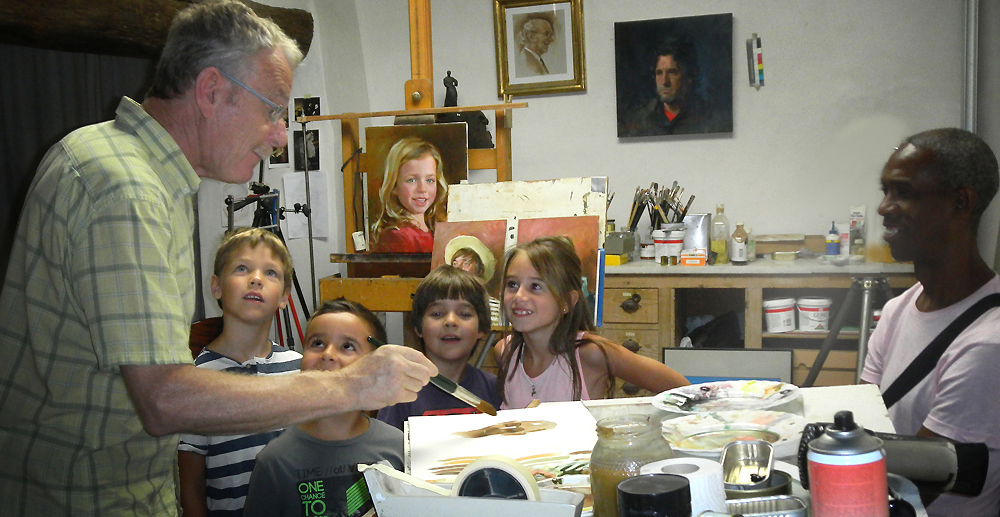
This week my friend Julian Despaigne came to visit me with a group of children from the village. Every year he organizes a kind of summer school, now children are on holiday. They do amazing things. Visits to the village monuments where he explains and tells stories from the history, treasure hunting through the streets and much more. Last week they visited the village blacksmith, and now they have paid me a visit in my studio. I told them something about portrait painting and mixing paint. In a five-minute demo I made a watercolour of the portrait of Julian. The children were spellbound.
It reminded me of a beautiful story that the famous graphic designer and illustrator Milton Glaser told in an interview with his friend and fellow artist James McMullan.
“There was a very specific moment when I was about four or five years old. My cousin came in with a paper bag and said, ” You want to see a pigeon?” I thought he had one in the bag, but he didn´t. Right before my eyes, he just drew it on the paper bag. At that moment the idea of inventing an image – it was the first time it had ever occurred to me that you could invent something and give it life – became clear. That was the moment of decision for me, and I never deviated from that. The only thing I ever wanted to do was something involved with making images.”
I myself as a child had a similar experience that made me decide that I would become an artist. (I will talk about that occurrence next week). If the children who visited me will go into art I do not know. Perhaps, who knows…
By the way, Julian is an amazing guy! Don´t forget to visit his website.
How I prepare watercolour paper
This week I made a short video to show you how I stretch watercolour paper.
There are numerous professional grade, watercolour blocks on the market. (See my last post.) But when I use single sheets, I stretch it myself, on board. This method makes it possible to work even on low quality paper in watercolour.
- First, I cut four strips of water-activated gummed paper tape at the correct length.
- Then, I moisten the water colour paper with a sponge.
- I leave it to absorb the water and to fully expand.
- I stick the wet paper onto the board and let it dry. In summer this takes an hour, in winter more than double that time.
- Once dry, the paper is tightly stretched.
- Once finished I cut, with a sharp knife, around the painting cropping the paper.
Now I can make my watercolour painting with no problems. The paper will not wrinkle when it comes into contact with water.

Painting a portrait in watercolour
“If you are self-employed, do you need a lot of self-discipline?” someone asked me a long time ago. “Of course!” was my answer, “because you need to know when to stop.” Unless you pay attention, you find yourself day and night behind the easel. I have had to think of that now I am seized with “watercolour fever”.
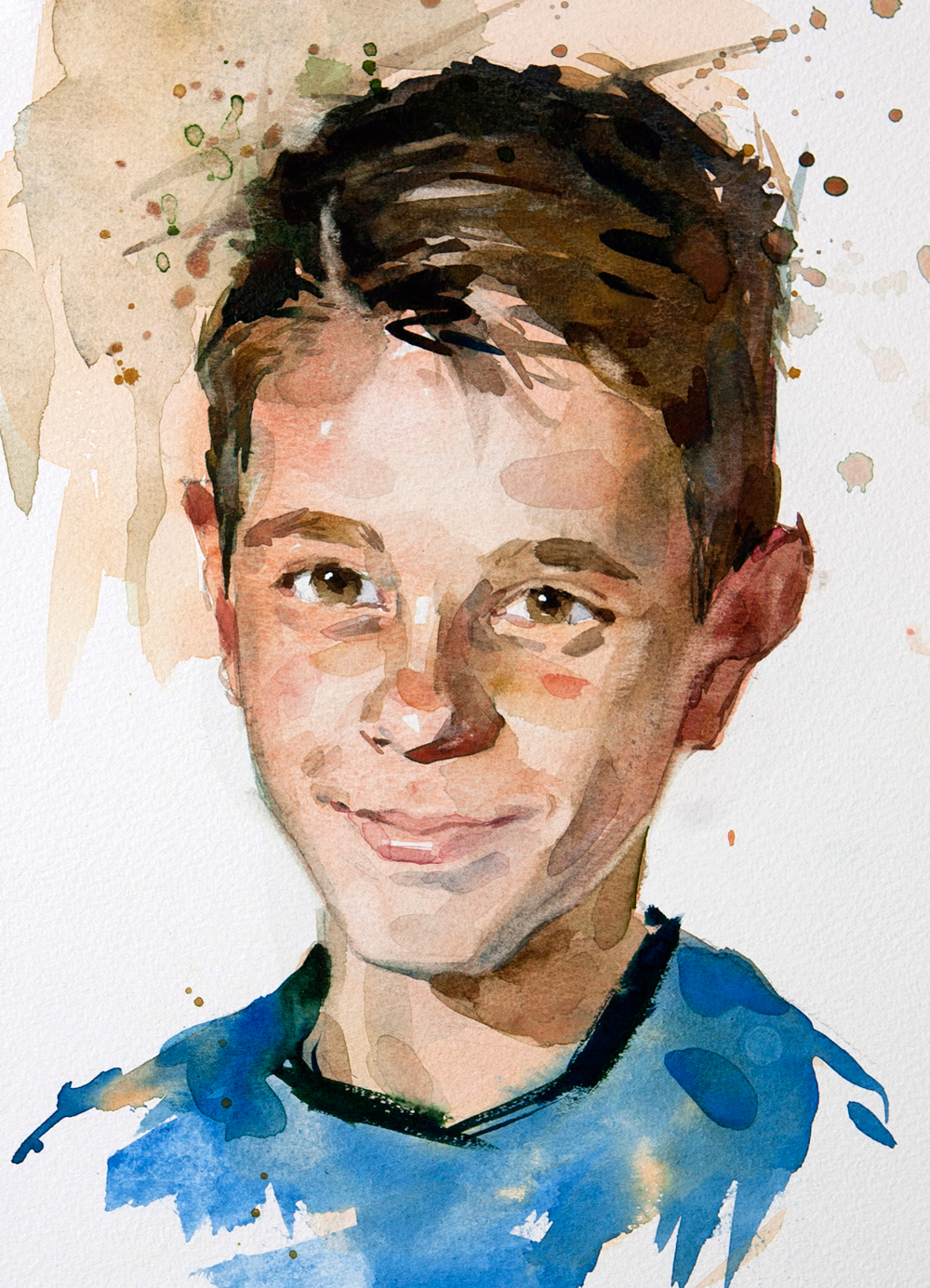
Two weeks ago I wrote you about a commission in watercolour. I finished the job but I could not shake myself free of watercolours as they captivated me. I attacked (after Van Gogh) a number of portraits in this beautiful technique. The working method in watercolour is opposed to that of oil. In oil you immediately start with the darkest parts, then the half tones and finally the lights. On the contrary, in watercolour you start with the light areas, (saving the high lights). Then the halftones and finally the darkest parts.
Already people have asked me for a tutorial and I have put it on the agenda for next year. Next post will be on the preparations for a watercolour portrait.

The colours on my palette:
- Cadmium Lemon Yellow
- Cadmium Red Light
- Yellow Ochre
- Raw Sienna
- Alizarine Crimson
- Phtalo Blue
- Cerulean Blue
- Sap Green
- Hookers Green
I prefer to work on Arches France, Bockingford or Fabriano paper.
Portrait commission in watercolour
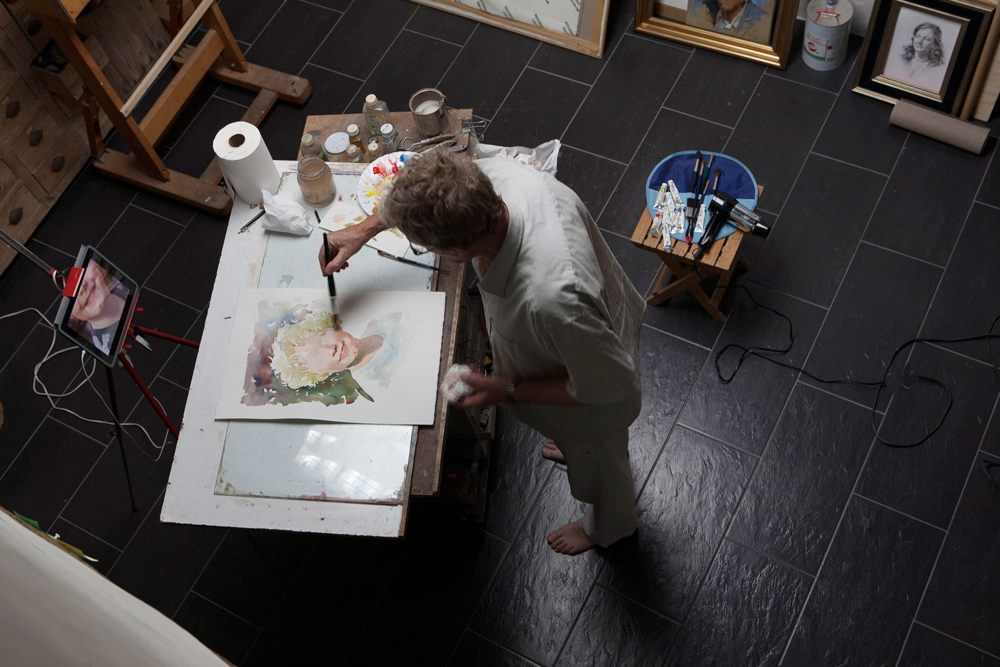
It’s been a long time since I made a commissioned portrait in watercolour. The technique is so different from oils that I need to change my mind substantially. I love this technique but I do it too little. So, today one of my good intentions: at least one portrait per month in watercolour. When the client gives me permission I will show you the end result.
I used watercolour: Rembrandt / Talens. Paper: Arches / France
Watercolour portraits
Almost all my commissions are portraits in oils. In in the past I made a few in watercolour. Here you see one of a boy. The other of my daughter that I made exactly fifteen years ago. If I had more time I would pay more attention to this fantastic technique. People often ask me to teach in this. But it still has too many secrets to me. Someday maybe?
